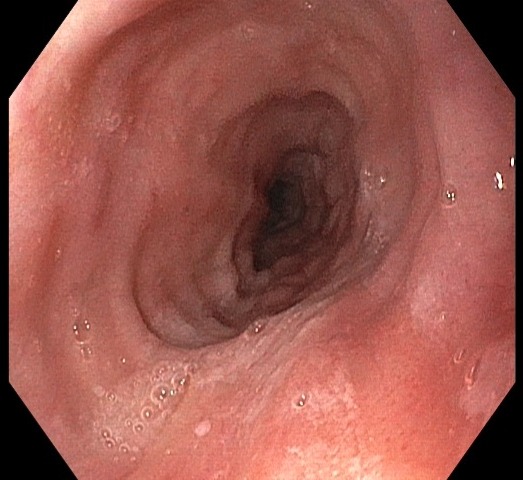Tuesday Poster Session
Category: Esophagus
P5017 - Lymphocytic Esophagitis Following Anterior Cervical Discectomy and Fusion: An Uncommon Cause of Postoperative Dysphagia
Tuesday, October 28, 2025
10:30 AM - 4:00 PM PDT
Location: Exhibit Hall
- BP
Brenden Pearce, DO (he/him/his)
HCA Healthcare
Myrtle Beach, SC
Presenting Author(s)
Brenden Pearce, DO1, Gary Drew, MD, MPH2, Yashaswi Koguru, MD1, Minh Nguyen, DO1, Naren S. Nallapeta, MD1
1HCA Healthcare, Myrtle Beach, SC; 2Grand Strand Medical Center, Myrtle Beach, SC
Introduction: Lymphocytic esophagitis (LyE) is a rare histologic subtype of chronic esophagitis first described by Rubio et al. in 2006 [1]. It is defined by peripapillary intraepithelial lymphocytosis, marked spongiosis, and minimal or absent intraepithelial granulocytes without infectious cause [2,3]. Although no consensus threshold exists, >20 lymphocytes per high-power field is commonly accepted [2,3]. LyE presents with nonspecific symptoms such as dysphagia, nausea, or chest discomfort [4]. It is important to distinguish LyE from eosinophilic esophagitis and esophageal lichen planus through biopsy after discontinuation of PPI therapy [5]. Endoscopic findings may include linear furrows, rings, strictures, or white plaques, though may also be normal [4]. LyE is most often diagnosed in women over 60 and has been associated with tobacco use, IBD, and motility disorders, and mucosal injury [4,6,7]. We present a case of LyE in a 74-year-old man whose dysphagia began after anterior cervical discectomy and fusion (ACDF).
Case Description/
Methods: 74-year-old man with COPD, ischemic heart disease, prostate cancer, and recent ACDF presented with progressive solid food dysphagia shortly after surgery. He described food sticking in the neck region, requiring water and increased mastication. Barium swallow was unremarkable. He tolerated soft foods but avoided meat unless finely chopped. There was no weight loss, reflux, or odynophagia. Initial EGD showed linear furrows, trachealization, and a distal esophageal stricture. Gastric biopsies revealed Helicobacter pylori-associated chronic gastritis with focal intestinal metaplasia. Esophageal biopsies demonstrated LyE. Despite H. pylori eradication, dysphagia persisted. Repeat EGD confirmed persistent LyE.
Discussion: LyE pathogenesis remains unclear but is hypothesized to involve chronic mucosal irritation [6]. In this case, the timing of symptom onset after ACDF suggests iatrogenic esophageal injury, due to retraction, ischemia, or mechanical stress, which may have triggered a lymphocytic response. While ACDF is a known cause of postoperative dysphagia, its association with LyE is rarely reported. The lack of eosinophils, atopy, or infection suggests a non-allergic, irritation-driven mechanism [3,4,6]. This supports the theory that LyE may reflect a reactive process rather than a primary immune-mediated disorder. Further study is needed to clarify its pathophysiology. Generative AI writing tool was used to aid grammar and formatting of this publication.

Figure: Esophageal Rings and Furrows

Figure: Esophageal biopsy demonstrating lymphocytic infiltrate
Disclosures:
Brenden Pearce indicated no relevant financial relationships.
Gary Drew indicated no relevant financial relationships.
Yashaswi Koguru indicated no relevant financial relationships.
Minh Nguyen indicated no relevant financial relationships.
Naren Nallapeta indicated no relevant financial relationships.
Brenden Pearce, DO1, Gary Drew, MD, MPH2, Yashaswi Koguru, MD1, Minh Nguyen, DO1, Naren S. Nallapeta, MD1. P5017 - Lymphocytic Esophagitis Following Anterior Cervical Discectomy and Fusion: An Uncommon Cause of Postoperative Dysphagia, ACG 2025 Annual Scientific Meeting Abstracts. Phoenix, AZ: American College of Gastroenterology.
1HCA Healthcare, Myrtle Beach, SC; 2Grand Strand Medical Center, Myrtle Beach, SC
Introduction: Lymphocytic esophagitis (LyE) is a rare histologic subtype of chronic esophagitis first described by Rubio et al. in 2006 [1]. It is defined by peripapillary intraepithelial lymphocytosis, marked spongiosis, and minimal or absent intraepithelial granulocytes without infectious cause [2,3]. Although no consensus threshold exists, >20 lymphocytes per high-power field is commonly accepted [2,3]. LyE presents with nonspecific symptoms such as dysphagia, nausea, or chest discomfort [4]. It is important to distinguish LyE from eosinophilic esophagitis and esophageal lichen planus through biopsy after discontinuation of PPI therapy [5]. Endoscopic findings may include linear furrows, rings, strictures, or white plaques, though may also be normal [4]. LyE is most often diagnosed in women over 60 and has been associated with tobacco use, IBD, and motility disorders, and mucosal injury [4,6,7]. We present a case of LyE in a 74-year-old man whose dysphagia began after anterior cervical discectomy and fusion (ACDF).
Case Description/
Methods: 74-year-old man with COPD, ischemic heart disease, prostate cancer, and recent ACDF presented with progressive solid food dysphagia shortly after surgery. He described food sticking in the neck region, requiring water and increased mastication. Barium swallow was unremarkable. He tolerated soft foods but avoided meat unless finely chopped. There was no weight loss, reflux, or odynophagia. Initial EGD showed linear furrows, trachealization, and a distal esophageal stricture. Gastric biopsies revealed Helicobacter pylori-associated chronic gastritis with focal intestinal metaplasia. Esophageal biopsies demonstrated LyE. Despite H. pylori eradication, dysphagia persisted. Repeat EGD confirmed persistent LyE.
Discussion: LyE pathogenesis remains unclear but is hypothesized to involve chronic mucosal irritation [6]. In this case, the timing of symptom onset after ACDF suggests iatrogenic esophageal injury, due to retraction, ischemia, or mechanical stress, which may have triggered a lymphocytic response. While ACDF is a known cause of postoperative dysphagia, its association with LyE is rarely reported. The lack of eosinophils, atopy, or infection suggests a non-allergic, irritation-driven mechanism [3,4,6]. This supports the theory that LyE may reflect a reactive process rather than a primary immune-mediated disorder. Further study is needed to clarify its pathophysiology. Generative AI writing tool was used to aid grammar and formatting of this publication.

Figure: Esophageal Rings and Furrows

Figure: Esophageal biopsy demonstrating lymphocytic infiltrate
Disclosures:
Brenden Pearce indicated no relevant financial relationships.
Gary Drew indicated no relevant financial relationships.
Yashaswi Koguru indicated no relevant financial relationships.
Minh Nguyen indicated no relevant financial relationships.
Naren Nallapeta indicated no relevant financial relationships.
Brenden Pearce, DO1, Gary Drew, MD, MPH2, Yashaswi Koguru, MD1, Minh Nguyen, DO1, Naren S. Nallapeta, MD1. P5017 - Lymphocytic Esophagitis Following Anterior Cervical Discectomy and Fusion: An Uncommon Cause of Postoperative Dysphagia, ACG 2025 Annual Scientific Meeting Abstracts. Phoenix, AZ: American College of Gastroenterology.
